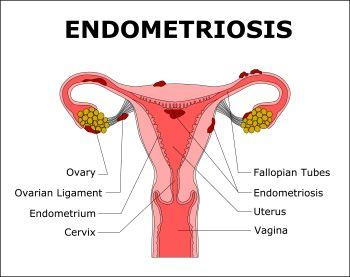Endometriosis is a female condition in which tissue that's similar to uterine lining begins growing on the outside of the uterus, often affecting the ovaries, fallopian tubes, and pelvic tissue. During your cycle, the endometrial tissue then becomes thicker until it breaks down and bleeds, and due to how this tissue can’t be removed from the body, it gets trapped. Over time, this can lead to scar tissue (known as  adhesions) on the reproductive organs.
adhesions) on the reproductive organs.
This condition affects as many as 11 percent of US woman between the ages of 15 and 44, most often affecting women in their 30s and 40s. This condition can also make it more challenging for women to get pregnant.
What are the symptoms of endometriosis?
The classic symptom of endometriosis is abdominal pain that is usually worse during your menstrual cycle. While a lot of women complain of some abdominal discomfort during menstruation, women with endometriosis often complain of very painful periods, which may even radiate to the lower back.
Women with endometriosis may also experience very heavy periods or breakthrough bleeding (bleeding between cycles). You may also notice pelvic pain during sex or with bowel movements, as well as bloating, constipation, diarrhea, nausea, or fatigue.
All symptoms will vary from woman to woman. For instance, some women may have very severe symptoms but only have milder cases of endometriosis, while those with more severe cases may experience little-to-no-discomfort. Everyone is different; however, if you are experiencing new, persistent, or worsening pelvic pain, it’s important that you talk with your gynecologist.
If you are trying to conceive you may also find it more difficult to do so. Sometimes women don’t often find out that they have endometriosis until they visit their OBGYN to discuss problems getting pregnant.
How is endometriosis diagnosed?
During your evaluation, your OBGYN will ask you questions about the symptoms that you are experiencing. From there, a couple of tests will be performed in order to pinpoint specific signs and symptoms of endometriosis. These tests include a traditional pelvic exam or an ultrasound. In some instances, an MRI exam or a laparoscopy (a minor surgical procedure that allows a doctor to examine the inside of the abdomen and uterus) may be recommended to make a definitive diagnosis.
How is this condition treated?
Since there is no cure for endometriosis the goal of treatment is to manage your symptoms. As with most conditions, we will recommend more conservative treatment options at first to see if they are effective. Common treatment options include,
- Pain medications (either over-the-counter or prescription-strength)
- Hormone therapy (e.g. birth control pills; progestin therapy)
- Fertility treatment (for women who are having trouble conceiving)
- Laparoscopic surgery to remove excess endometrial tissue
If you are experiencing symptoms of endometriosis, it’s important that you talk to a gynecologist as soon as possible.
